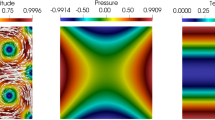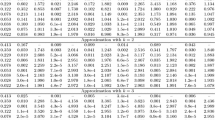Abstract
This paper deals with the analysis of new mixed finite element methods for the Brinkman equations formulated in terms of velocity, vorticity and pressure. Employing the Babuška–Brezzi theory, it is proved that the resulting continuous and discrete variational formulations are well-posed. In particular, we show that Raviart–Thomas elements of order \(k \ge 0\) for the approximation of the velocity field, piecewise continuous polynomials of degree \(k+1\) for the vorticity, and piecewise polynomials of degree k for the pressure, yield unique solvability of the discrete problem. On the other hand, we also show that families of finite elements based on Brezzi–Douglas–Marini elements of order \(k+1\) for the approximation of velocity, piecewise continuous polynomials of degree \(k+2\) for the vorticity, and piecewise polynomials of degree k for the pressure ensure the well-posedness of the associated Galerkin scheme. We note that these families provide exactly divergence-free approximations of the velocity field. We establish a priori error estimates in the natural norms with constants independent of the viscosity and we carry out the reliability and efficiency analysis of a residual-based a posteriori error estimator. Finally, we report several numerical experiments illustrating the behaviour of the proposed schemes and confirming our theoretical results on unstructured meshes. Additional examples of cases not covered by our theory are also presented.








Similar content being viewed by others
References
Ainsworth, M., Oden, J.: A posteriori error estimation in finite element analysis. In: Pure and Applied Mathematics. Wiley, New York (2000)
Alvarez, M., Gatica, G.N., Ruiz-Baier, R.: Analysis of a vorticity-based fully-mixed formulation for the 3D Brinkman–Darcy problem. CI\(^2\)MA preprint 2014-34. http://www.ci2ma.udec.cl/publicaciones/prepublicaciones
Amara, M., Capatina-Papaghiuc, D., Trujillo, D.: Stabilized finite element method for Navier–Stokes equations with physical boundary conditions. Math. Comput. 76(259), 1195–1217 (2007)
Amara, M., Chacón Vera, E., Trujillo, D.: Vorticity–velocity–pressure formulation for Stokes problem. Math. Comput. 73(248), 1673–1697 (2004)
Amestoy, P.R., Duff, I.S., l’Excellent, J.Y.: Multifrontal parallel distributed symmetric and unsymmetric solvers. Comput. Methods Appl. Mech. Eng. 184(2–4), 501–520 (2000)
Anaya, V., Mora, D., Gatica, G.N., Ruiz-Baier, R.: An augmented velocity–vorticity–pressure formulation for the Brinkman problem. Int. J. Numer. Methods Fluids (2015). doi:10.1002/fld.4041
Anaya, V., Mora, D., Reales, C., Ruiz-Baier, R.: Stabilized mixed approximation of axisymmetric Brinkman flows. ESAIM. Math. Model. Numer. Anal. 49(3), 855–874 (2015)
Anaya, V., Mora, D., Ruiz-Baier, R.: An augmented mixed finite element method for the vorticity–velocity–pressure formulation of the Stokes equations. Comput. Methods Appl. Mech. Eng. 267, 261–274 (2013)
Arnold, D.N., Falk, R.S., Gopalakrishnan, J.: Mixed finite element approximation of the vector Laplacian with Dirichlet boundary conditions. Math. Models Methods Appl. Sci. 22(9), 1–26 (2012). (1250024)
Babuška, I., Gatica, G.N.: A residual-based a posteriori error estimator for the Stokes–Darcy coupled problem. SIAM J. Numer. Anal. 48(2), 498–523 (2010)
Bercovier, M., Engelman, M.: A finite element for the numerical solution of viscous incompressible flows. J. Comput. Phys. 30, 181–201 (1979)
Bernardi, C., Chorfi, N.: Spectral discretization of the vorticity, velocity, and pressure formulation of the Stokes problem. SIAM J. Numer. Anal. 44(2), 826–850 (2007)
Bochev, P.V.: Analysis of least-squares finite element methods for the Navier–Stokes equations. SIAM J. Numer. Anal. 34(5), 1817–1844 (1997)
Bochev, P.V., Gunzburger, M.: Least-squares finite element methods. In: Applied Mathematical Sciences, vol. 166. Springer, New York (2009)
Boffi, D., Brezzi, F., Fortin, M.: Mixed finite element methods and applications. In: Springer Series in Computational Mathematics, vol. 44. Springer, Heidelberg (2013)
Bustinza, R., Gatica, G.N., González, M.: A mixed finite element method for the generalized Stokes problem. Int. J. Numer. Methods Fluids 49(8), 877–903 (2005)
Carstensen, C.: A posteriori error estimate for the mixed finite element method. Math. Comput. 66(218), 465–476 (1997)
Chang, C.L.: A mixed finite element method for the Stokes problem: an acceleration–pressure formulation. Appl. Math. Comput. 36(2), 135–146 (1990)
Chang, C.L., Jiang, B.-N.: An error analysis of least-squares finite element method of velocity–pressure–vorticity formulation for the Stokes problem. Comput. Methods Appl. Mech. Eng. 84(3), 247–255 (1990)
Clément, P.: Approximation by finite element functions using local regularisation. RAIRO Modél. Math. Anal. Numér. 9, 77–84 (1975)
Cockburn, B., Cui, J.: An analysis of HDG methods for the vorticity–velocity–pressure formulation of the Stokes problem in three dimensions. Math. Comput. 81(279), 1355–1368 (2012)
Duan, H.-Y., Liang, G.-P.: On the velocity–pressure–vorticity least-squares mixed finite element method for the 3D Stokes equations. SIAM J. Numer. Anal. 41(6), 2114–2130 (2003)
Dubois, F., Salaün, M., Salmon, S.: First vorticity–velocity–pressure numerical scheme for the Stokes problem. Comput. Methods Appl. Mech. Eng. 192(44–46), 4877–4907 (2003)
Frey, P.J., George, P.-L.: Maillages, Applications aux éléments finis. Hermès, Paris (1999)
Gatica, G.N.: A simple introduction to the mixed finite element method. Theory and applications. In: Springer Briefs in Mathematics. Springer, New York (2014)
Gatica, G.N., Gatica, L.F., Márquez, A.: Augmented mixed finite element methods for a vorticity-based velocity–pressure–stress formulation of the Stokes problem in 2D. Int. J. Numer. Methods Fluids 67(4), 450–477 (2011)
Gatica, G.N., Gatica, L.F., Márquez, A.: Analysis of a pseudostress-based mixed finite element method for the Brinkman model of porous media flow. Numer. Math. 126(4), 635–677 (2014)
Gatica, G.N., Heuer, N., Meddahi, S.: On the numerical analysis of nonlinear twofold saddle point problems. IMA J. Numer. Anal. 23(2), 301–330 (2003)
Gatica, G.N., Oyarzúa, R., Sayas, F.J.: A residual-based a posteriori error estimator for a fully-mixed formulation of the Stokes-Darcy coupled problem. Comput. Methods Appl. Mech. Eng. 200(21–22), 1877–1891 (2011)
Girault, V.: Incompressible finite element methods for Navier–Stokes equations with non-standard boundary conditions in \(\mathbb{R}^3\). Math. Comput. 51(183), 55–74 (1988)
Girault, V., Raviart, P.A.: Finite Element Methods for Navier–Stokes Equations. Theory and Algorithms. Springer, Berlin (1986)
Howell, J.S.: Approximation of generalized Stokes problems using dual-mixed finite elements without enrichment. Int. J. Numer. Methods Fluids 67(2), 247–268 (2011)
Karlsen, K.H., Karper, T.K.: Convergence of a mixed method for a semi-stationary compressible Stokes system. Math. Comput. 80, 1459–1498 (2011)
Pontaza, J.P., Reddy, J.N.: Spectral/hp least-squares finite element formulation for the Navier–Stokes equations. J. Comput. Phys. 190(2), 523–549 (2003)
Salaün, M., Salmon, S.: Numerical stabilization of the Stokes problem in vorticity–velocity–pressure formulation. Comput. Methods Appl. Mech. Eng. 196(9–12), 1767–1786 (2007)
Salaün, M., Salmon, S.: Low-order finite element method for the well-posed bidimensional Stokes problem. IMA J. Numer. Anal. 35, 427–453 (2015)
Speziale, C.G.: On the advantages of the vorticity–velocity formulations of the equations of fluid dynamics. J. Comput. Phys. 73(2), 476–480 (1987)
Vassilevski, P.S., Villa, U.: A mixed formulation for the Brinkman problem. SIAM J. Numer. Anal. 52(1), 258–281 (2014)
Verfürth, R.: A review of a posteriori error estimation and adaptive-mesh-refinement techniques. Wiley-Teubner, Chichester (1996)
Acknowledgments
Stimulating discussions with Prof. Gabriel N. Gatica are gratefully acknowledged. In addition, V. Anaya was partially supported by CONICYT-Chile through FONDECYT postdoctorado No. 3120197, by project Inserción de Capital Humano Avanzado en la Academia No. 79112012, and DIUBB through Project 120808 GI/EF. D. Mora was partially supported by CONICYT-Chile through FONDECYT Project No. 1140791, by DIUBB through Project 120808 GI/EF, and Anillo ANANUM, ACT1118, CONICYT (Chile). R. Oyarzúa was partially supported by CONICYT-Chile through FONDECYT Project No. 1121347, by DIUBB through Project 120808 GI/EF, and Anillo ANANUM, ACT1118, CONICYT (Chile). R. Ruiz-Baier acknowledges support by the Swiss National Science Foundation through the Grant SNSF PP00P2-144922. This work was advanced during a visit of V. Anaya and D. Mora to the Institut des Sciences de la Terre, University of Lausanne.
Author information
Authors and Affiliations
Corresponding author
Rights and permissions
About this article
Cite this article
Anaya, V., Mora, D., Oyarzúa, R. et al. A priori and a posteriori error analysis of a mixed scheme for the Brinkman problem. Numer. Math. 133, 781–817 (2016). https://doi.org/10.1007/s00211-015-0758-x
Received:
Revised:
Published:
Issue Date:
DOI: https://doi.org/10.1007/s00211-015-0758-x




